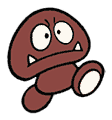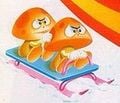Goombo
- Not to be confused with Goomba.
Template:Species-infobox Goombo[1] (also known by its original Japanese name Chibibo[2][3]) is a variety of Goomba that resides in Sarasaland. Goombos have only appeared in Super Mario Land, and were only referred to as such in the American digital manual for the Nintendo 3DS Virtual Console release of Super Mario Land in 2011, twenty-two years after the original game's release. Nintendo Power also refers to these as relatives of Goombas.
Like Goombas, Goombos slowly meander to the side aiming to hit Mario. They will not turn around unless they hit an obstacle, and will wander off the edge of platforms. Once stomped or shot with a Superball, Mario will be rewarded with one hundred points. After Bombshell Koopas, Goombos are the most common enemy in the game, appearing in all kingdoms except for the Easton Kingdom.
A Goombo makes a cameo in the Super Mario Land microgame in WarioWare Gold, where it is one of the enemies Mario must throw a Superball at.
Profiles
Super Mario Land
- 3DS Virtual Console manual bio: "This timid mushroom toddles along the ground."
Gallery
- SML Goombo Sprites.png
Sprites of a normal Goombo (left) and a stomped Goombo (right)
Names in other languages
| Language | Name | Meaning |
|---|---|---|
| Japanese | チビボー[4] Chibibō |
A portmanteau of Chibi and Kuribō. |
| French | Chibibo |
- |
| German | Tschibibo |
Japanese/English name adapted to German spelling |
| Italian | Chibibo/Goombo |
- |
| Spanish | Goombo |
- |
Trivia
- The English instruction booklet calls this enemy "timid"[2], whereas the Japanese instruction booklet calls it "weak"[4].
- Like certain other Super Mario Land characters, Goombos were made into finger puppets.
References
| Super Mario Land | |
|---|---|
| Protagonists | Mario • Princess Daisy |
| Bosses | King Totomesu • Dragonzamasu (Tamao) • Hiyoihoi • Biokinton (Chicken) • Tatanga (Pagosu) |
| Locations | Sarasaland (Birabuto Kingdom • Muda Kingdom • Easton Kingdom • Chai Kingdom) |
| Levels | World 1-1 • World 1-2 • World 1-3 • World 2-1 • World 2-2 • World 2-3 • World 3-1 • World 3-2 • World 3-3 • World 4-1 • World 4-2 • World 4-3 • Expert Level |
| Items & vehicles | Super Mushroom • Superball Flower • Star • 1UP heart • Coin • Marine Pop • Sky Pop • Switch • Lift Block |
| Enemies & obstacles | Batadon • Bombshell Koopa • Bullet Biff • Bunbun • Chikako • Dropping lift • Falling block • Falling spike • Fly • Ganchan • Gao • Gunion • Goombo • Honen • Kumo • Mekabon • Nyololin • Pionpi • Pipe Fist • Piranha Plant • Pompon Flower • Roketon • Roto Disc • Suu • Tokotoko • Torion • Yurarin • Yurarin Boo |
| Other | Brick • Bonus game • Das Super Mario Spiel • Gallery • Glitches • Goal • Media • Mystery Block • Soundtrack |

